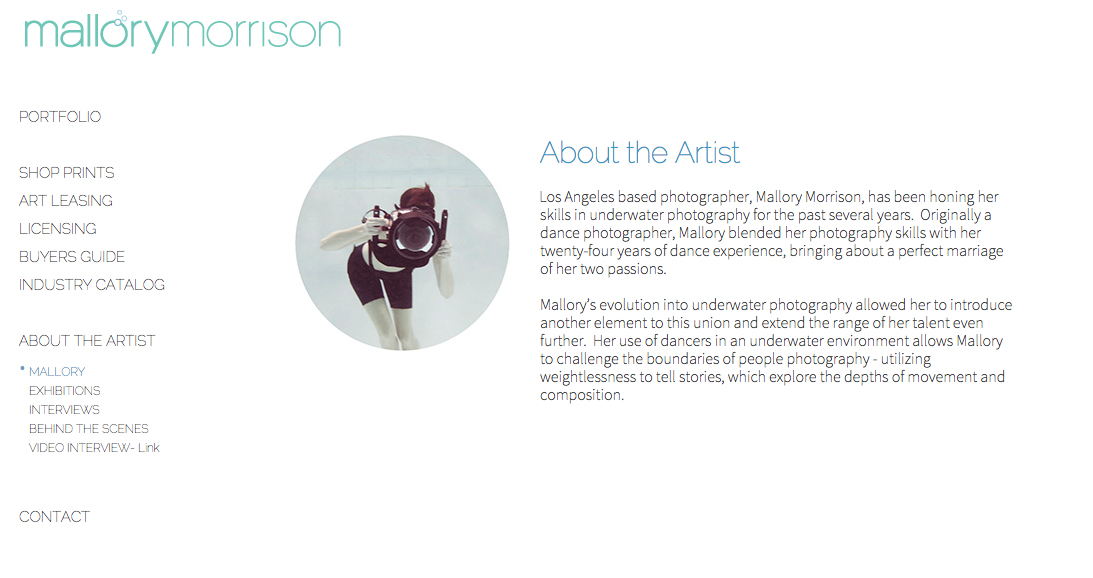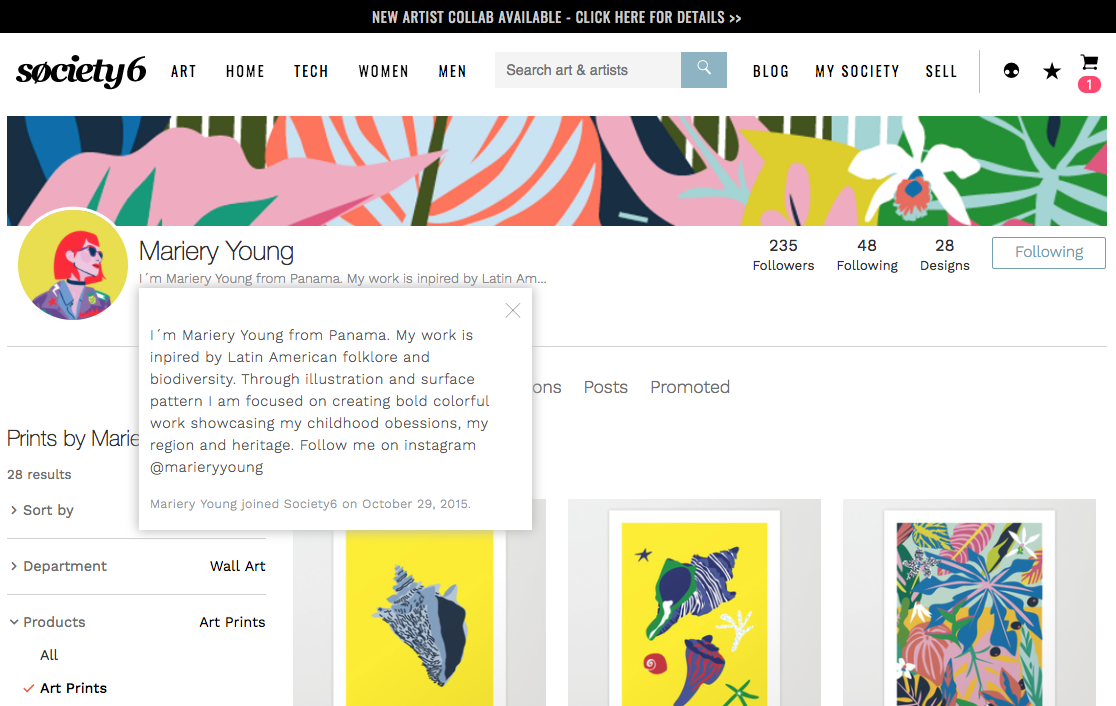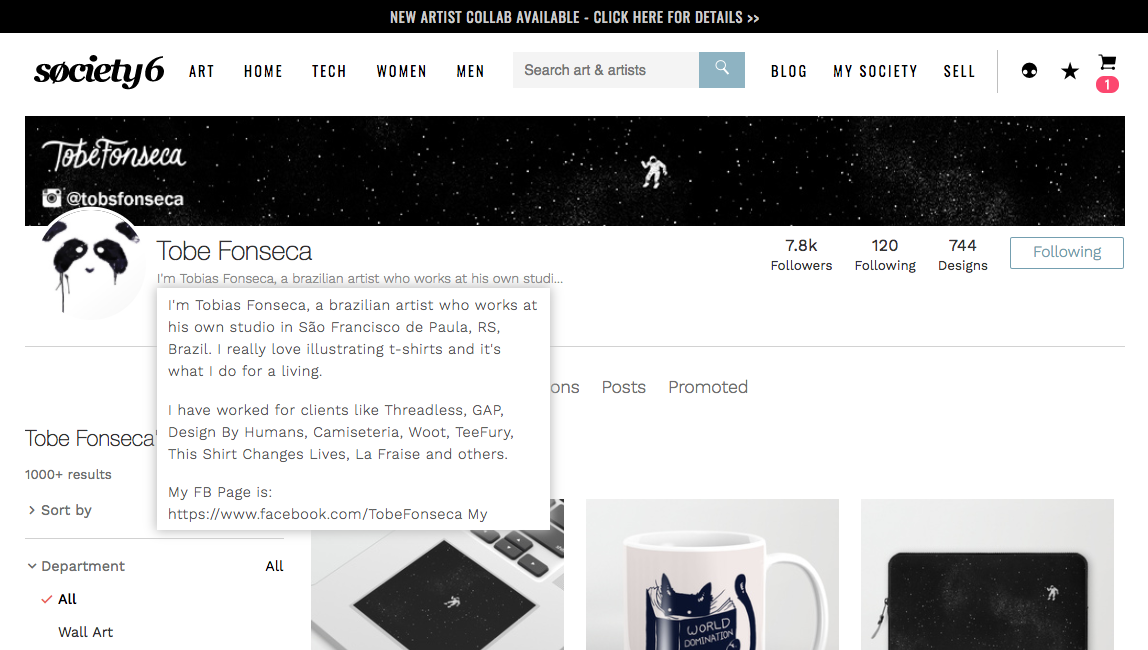50 words is all you need to get started.
Your artist bio is about connecting with someone and giving them a window into who you are. Keep it concise and engaging. If you focus on what is intriguing about your work, your artist bio can be a powerful tool to help your biggest fans become repeat customers. With your Society6 bio at the very top of your shop page, you’ll want to take advantage of it’s prime location.
We asked photographer Mallory Morrison to draw up her top tips on writing an artist bio. Her distinct blend of dance-inspired poses and underwater photography has kept her active in the art scene since she began shooting in 2007. She’s taught several workshops on how to shoot underwater and her work continues to be purchased, shown and licensed across the US and internationally.
1. Get straight to the point
For the basic info, stick to your highlight reel! While it might be important to you, most customers aren’t going make a purchase because they know your cat’s name, where you went to high school, or how much you have struggled to “get where you are today” (unless, of course, it’s obvious to a customer that it’s relevant to your artwork).
These are the items most important to your bio. It usually makes for a more interesting read to lead with your inspiration.
- Where you are currently based. Only mention where you were born or grow up if it informs your current work and is worth noting.
- Your art medium(s) and special techniques
- Inspiration and what you are passionate about
- Your biggest achievements. This can be awards, high profile clients you’ve worked for, or gallery shows
Bonus Tip: When describing how long you have been doing something, use the year you started. Example: “since 2013” vs. “for 5 years”. This way you won’t have to update it every year.
2. Use your voice
As a rule of thumb, most bio’s are written in the third person. It should read as if someone else is writing the bio about you. Someone who is passionate about your work. Not a stuffy gallerist who is trying to upsell to a collector. Be honest and authentic about the artist that you are. And if your art is a hobby that makes you a little money on the side, there’s no need to mention that.
“You are an artist, no matter how often you make art or how much you make from it.”
If you do choose to write your artist bio in the first person, make sure to include all of the same info listed in #1.
Tone is also something important to think about. Have it match the personality of your work, to an extent. If you have quirky, playful style of work, let that show in the words you chose, however, be careful not to let it sound too unprofessional.
Bonus Tip: Have confidence. Avoid using phrases like “I hope you like my work” or “this is first time showing my work”. Be proud of your work and let your passion for it show through your bio.
3. The length depends on your audience
It’s common to have multiple versions, in different lengths. Each version will likely emphasize various achievements relative to where your bio is being read.
- Society6 shop: This will be the shortest one–about 50 words long. Make sure to include your location, medium, and inspiration. Then finish with your social media/website links (2-3 max) and you are done!
- Website: This one can be a little longer, around 100-150 words. Anything longer and you’ll tend to lose your fans. With this expanded version, let your personality show. Add a few extra sentences about your inspiration and process. Get them hooked and connected to you.
- Gallery show: This should be around 100-150 words, but you’ll want to focus more on the common themes in your work as a whole, what has influenced you as an artist, and a few notable achievements.
4. Give them what they want
Be sure to answer the number one question people ask you about your work! From process to inspiration, usually there is a common question that your work will elicit. That will get you on the right track to engage your customers and help them emotionally connect with your work.
Bonus tip: If you consider yourself a “bad” writer, this section is where you should start. Record a voice memo about why you started making your work and what keeps you inspired. Listen back and take the highlights!
5. Trim it down and proof read
Once you have a few different versions for different purposes, send it over to a trusted, highly-literate friend to have a look. Since spell check isn’t a concern, ask them to focus on grammar and tone. Is it professional yet approachable? Is everything in there useful and necessary? And the final test–does your artist bio feel like you?
Bonus tip: If English is not your first language, make sure to get someone to proof it who is a native English speaker.
Make sure you have all of the essentials and don’t overthink it. As you grow as an artist, so will your bio writing skills. This is one of the most important things to have out there to support the work you show. It’ll help fans, brands and customers get to know the artist behind the work. Be authentic and let them in!



Comments